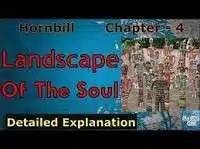
Landscape of the Soul Summary in English is written by experts. Go through and gain confidence. We at edumantra highly appreciate your feedback regarding Landscape of the Soul Class 11 Summary in English.
Landscape of the Soul Summary in English
By- Nathalie Trouveroy
A wonderful tale is told about the Chinese painter Wu daozi who lived in the 8th century. He was engaged by the Emperor to paint on the palace wall. It was the painter’s last painting. He hid his work behind a screen which only the Emperor could see. The emperor admired the scene of forests, mountains, waterfalls and clouds, humans on hilly paths and birds in the sky. In the cave at the foot of the mountain, the painter said, lived a spirit. He clapped his hand and the cave door opened. The inside was no less splendid. He entered the cave with the emperor following him. But before the emperor could move, the entrance to the cave closed. Even the painting on the wall also disappeared. The artist was never seen again.
Such stories are common in Chinese books written by great philosophers like Confucius and Zhuangzi. They reveal the spirit in which art was considered in ancient China. Contrast this story to a representative Western painting. A famous painter of Flanders wouldn’t draw the eye of a dragon he had painted. He had a fear that with open eyes, the dragon would fly out of the painting.
There is a third story of 15th century Antwerp. A blacksmith called Quinten Metsys fell in love with a painter’s daughter. The father rejected his suit because of his law profession. So Quinten one day got into the studio and painted a fly on his latest canvas. It looked so realistic that the painter tried to drive it away. Then he realised what had happened. He accepted Quinten as his apprentice. Quinten married his beloved and became one of the most famous painters of his age.
The two stories show what each form of art tried to achieve. The European art excelled in creating perfect likeness: In Asia, the art presented the inner life and spirit.
In the Chinese story, the emperor admires the outer appearance, but the artist reveals to him the true meaning of his work. The Emperor may rule over the conquered land but only the artist knows the way within, the mysterious works of the universe.
A classical Chinese landscape, unlike Western painting, does not present an actual view. The European painter wants you to look at the landscape exactly as he saw it from a particular angle. The Chinese landscape is not ‘realistic’. You can enter it from any point. He only creates a path for your eyes to travel up and down in a leisurely fashion. This method is illustrated best in the case of a scroll. As you roll the painting scroll up to move on to another painting, you find a dimension of time in it. The viewer has to travel through the painting along with the painter. The viewer’s participation is both physical and mental. The reason is that the landscape is an Inner one, a spiritual one.
This concept is expressed as shanshui. Which literally means mountain water. The two words together represent the landscape, two complementary poles. The vertical mountain is Yang. Which is stable and warm. The horizontal water isyin—resting on the earth, moist and cool. It is feminine while Yangis masculine. This is the basic notion of daoism.
In between the receptive feminine and the active Yang—the two sources of universal energy—Is a third element, the middle empty space, where their interaction takes place. It is essential. Hence, the Chinese landscape leaves white, unpainted space. This is also the field where man plays a key role. He becomes the medium of communication between poles of the universe. He is the eye of the landscape.
We hope you are enjoying the Landscape of the Soul Summary in English
Landscape of the Soul- Introduction